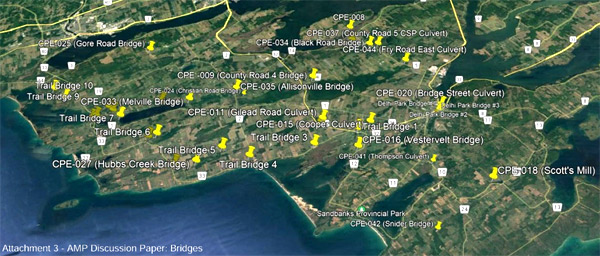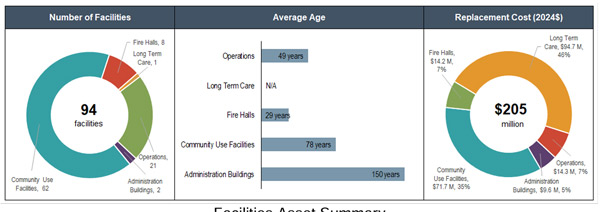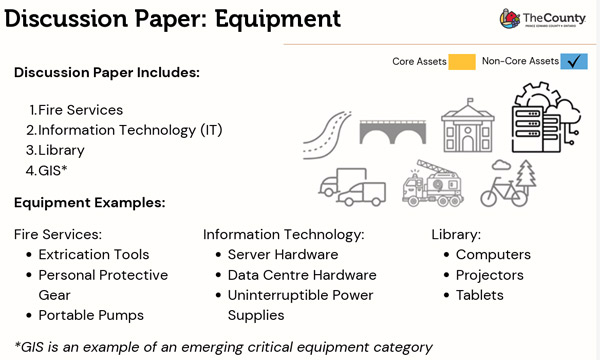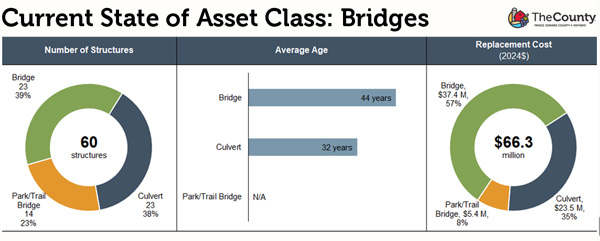County assets discussion continues with bridges, facilities and equipment
Administrator | May 19, 2025 | Comments 0

By Sharon Harrison
Bridges, buildings and equipment were the three topics discussed Thursday at Shire Hall for the second in a series of three informal council and staff working sessions on the County’s assets.
The first meeting in the series (held April 24) began a process of in-depth discussions on how the municipality’s assets are managed, providing an introduction to asset management planning, as well as covering the first topic, roads. (That story linked at the end of this one).
The relaxed conversational format, where the public could observe proceedings, but not participate, was not a regular council or committee of the whole meeting. This meeting saw just nine of 14 council members present for the discussion.
No decisions are to be made at any of the three working sessions. Further, in-depth discussion is to take place at a public meeting on Aug. 28 where all asset classes are to be discussed together, and where decision on taxpayer implications are to be made.
The County is proposing to update and expand its asset management plan (AMP), which comes as a request from the province for every municipality to complete by July 1. The process involves identifying the resources, activities and costs needed for maintaining, updating or replacing the County’s infrastructure.
The AMP will include proposed levels of service (LoS) and a long-term financial strategy to achieve the LoS ultimately decided upon. While a work-in-progress, and described as a living document, the asset management plan is expected to be finalized in September, and is to be updated annually.
Details on the three asset classes discussed in this working session are outlined below.
 FACILITIES
FACILITIES
The County owns and manages 94 facilities/buildings that support the provision of municipal services, 84 per cent are heritage buildings.
They include 63 community use facilities (average age 78 years), 20 operations buildings (average age 49 years), eight fire halls (average age 29 years), two administration buildings (average age 150 years), and one long-term care facility (50 years old).
The total replacement cost is stated as $205 million, made up of $72 million (community facilities), $14 million (operations), $14.2 million (fire halls), $9.6 million (administration buildings), and $94.7 million (long-term care).
Three levels of service (LoS) options were presented to council in the facilities category, each with a different cost implication:
Option 1 – Invest in all public facing buildings prioritizing emergency repair and critical maintenance, followed by accessibility and then heritage. Achieving this LoS for the next 10 years (2025-2035) would require an estimated annual investment of $2.81 million;
OR
Option 2 – Reduce the number of public facing buildings that are priority by 25 per cent. Achieving this LoS for the next 10 years (2025-2035) would require an estimated annual investment of $2.34 million;
OR
Option 3 – Reduce the number of public facing buildings that are priority by 50 per cent. Achieving this LoS for the next 10 years (2025-2035) would require an estimated annual investment of $1.88 million.
Speaking to the lifecycle and inspections of buildings, facilities supervisor Mark Gilbert said two primary inspections are done on buildings, one for life safety (people working in the buildings) which is undertaken monthly, and which includes fire inspections. The health of all buildings is looked at on a quarterly basis, to include siding, fascia, concrete condition as well as the building condition generally.
Councillor John Hirsch noted that what hasn’t been addressed in the report is those buildings that the County could get rid of, where he said those haven’t been identified.
“What should our process be technically for identifying candidates for disposition, and we will have to look at the emotional aspect and those types of things also in the process,” said Hirsch.
Lisa Lindsay, director of recreation and community facilities, said it would be a very interesting and challenging process, and suggested a similar approach could be employed as the one used for the Wellington town hall. It could look at the cost of repairs, the utilization, and where there is duplication in the municipality.
“And are their partnerships involved for the required repairs and maintenance; are there other ways the buildings could be re-purposed and maximized,” outlined Lindsay. “Divesting doesn’t have to be such a dramatic removal of a building.”
 EQUIPMENT
EQUIPMENT
Example of equipment the municipality owns include fire services (extrication tools, personal protective gear, portable pumps, radio communications equipment), information technology (server hardware, data centre hardware, and uninterruptible power supplies), and library (computers, projectors, tablets, maker space equipment, physical collections, endpoint hardware, networking hardware).
While the focus of the discussion was on IT, fire and library, it was noted some equipment (related to parks and recreation, and roads, etc.) is not listed currently and is in the process of being inventoried, to be added later to the AMP.
Total replacement cost in the equipment category is $5.84 million, made up as follows:
-The average age of fire equipment assets is eight years – total replacement cost $2.11 million.
-The average age of information technology equipment assets is two to three years – total replacement cost $2.07 million.
-The average age of library equipment assets is two to three years – total replacement cost $1.66 million.
The proposed LoS for all equipment is that all assets should be maintained in a fair condition or better. Specifically for IT equipment, this would mean the average replacement cycles for various IT components would be as follows:
Uninterruptable power supply – three years
Endpoints (computers) – four years
Network gear, cabling, servers – five years.
“This is an age-based assessment condition and having it fair better would be that it is not past its useful life, so that’s the intent here to make sure that the IT doesn’t go over its useful life, and our ratio is going to be age-based,” said Arryn McNichol, acting director of finance and information technology.
Maintaining this LoS for would require an estimated annual investment of $1 million.
Quite a long discussion ensued on equipment, specifically as it pertains to fire department equipment.
Councillor Roy Pennell said he found eight years to be “extremely difficult to understand”, noting a pump he owns is 50 years old and starts any day of the week. “I think in some areas, we just replace stuff too soon because it’s eight-year-old type of thing.”
“With the amount of people we’ve got in the County paying the bill at the end, is there not cases where rather than replacing it, we say, that’s probably good for another four or five years?”
In the case of portable pumps, manager of engineering, David MacPherson, said it is more likely to be 15 years, not eight, where he said they maintain them, but the equipment also have a hard life.
MacPherson confirmed all the equipment is well very maintained and records are kept, “but we also get to a point of that end of life where we can’t operate to failure: when we need the equipment, we need the equipment.”
“We will get to a point where we will do an assessment, where age and use and all of these things come to fruition, and that’s when we will be bringing forward a capital request.”
Councillor Brad Nieman said he agreed with Pennell, and wanted to know if equipment was replaced due to age or manufacturers’ recommendation.
“At some point, you have to realize that we don’t have an endless supply of money; our money comes from the taxpayers, and the only way we are going to get more money is we raise taxes, and we are going to tax ourselves right out of the business,” expressed Nieman.
Pennell once again raised the question of why used fire equipment could not be purchased, versus new, specifically as the County grows. He used a magazine advertisement he had recently seen as an example: a 1990 model ladder truck with 10,000 kilometres on the clock for $175,000, fully guaranteed for two years and brought up to 2025 standards.
“If we needed a ladder truck for instance, would it be worthwhile looking at something like that rather than brand new?” Pennell asked.
Fire Chief, Chad Brown said it if wasn’t deemed to be a front-line truck, and if it was a back-up unit, it could be an option.
“If we are going to continue to make it a front-line truck, then we are going to continue to diminish our responsibility to do our front-line service because we can’t do certain things with an older truck,” explained Brown. “It may meet standards, but it doesn’t meet the standards that allow us to run it as a front-line truck.”
As Wellington has the proposal to build out, Brown said eventually the County will have a population and a service delivery expectation as a result of the types and styles of buildings that get built.
“Where an aerial truck [the County has one aerial truck] is required, and becomes a super-vital piece of equipment, we don’t do certain types of training, we have to provide our firefighters with a secondary means of egress,” expressed Brown. “Typically, we can get up to three stories with ladders, we can fight fires on ladders, we certainly have those capabilities.”
However, Brown emphasized that as the different types of developments start to build out, up to and including the eight-storey building up on top of the hill [Nicholas/Cumberland Street development near Delhi Park], the fire department now gets into a different type of call, not only interior structural, but high-rise fire fighting, which requires different fire fighting, different equipment, and so on, he said.
“We have been very clear, as Wellington grows and you start to permit four-storey buildings, down the road there is going to be a commitment to the change in the level of equipment,” he said. “As the community changes, so do does our service delivery options, and so too does our equipment needs, and so too does everything else.”
McNichol confirmed that when it comes to replacing things in terms of the end of useful life, the weakest indicator as to when an asset should be replaced is age-based.
“We really endeavour to get condition of our assets where possible, so when it comes to the end of its useful life, we just don’t replace it, we keep track of the condition of the asset, and then we replace it.”

BRIDGES
The County has 60 bridges and large structural culverts to maintain, made up of 23 bridges, 23 structural culverts, and 14 park/trail bridges.
The average age of County bridges is 44 years; and average is 32 years for culverts. The overall average condition of the County’s bridges right now is 69.9 BCI (bridge condition index), made up as follows:
Bridges average BCI = 74
Culverts average BCI = 64.9
Park/trail bridges average BCI = 63.5.
Replacement costs total $66.3 million, made up as follows:
Bridges $37.4 million
Culverts $23.5 million
Park/trail bridges $5.4 million.
County staff engaged Watson and Associates to estimate the annual cost required to maintain the lifecycle of all municipal bridges at a BCI of 70 or higher. Maintaining this level of service would require an estimated annual investment of $1.23 million.
“We are in good shape, and we are right by the BCI numbers that we want, but we do have bridges in poor conditions and those are the ones we should be focusing on, MacPherson said.
Nieman raised the cost of replacing bridges and asked why aren’t alternatives being used or considered, as well as accessing different technologies, where MacPherson said options were limited for the big-sized culverts.
MacPherson did say for all designs now, the County is asking for all options to be readily looked at through the design phase, confirming that with the smaller bridges, there were more options available.
“If there is a culvert that we are going to look at replacing, or a bridge, we are asking to look at the rehabilitation, the structure replacement itself, and can it be done with the Bailey bridge, or can it be done instead of a bridge or structure, can it be replaced with a culvert,” he outlined. “We are looking at all those options (pre-fabricated, Bailey bridge, for example).”
MacPherson noted that bridges on the Millennium Trail were designed for rail traffic.
“If that’s what we need for, because it’s not just going to be designed for pedestrian traffic because there is ATVs and motorized vehicles that use the trail, but it’s not a CN rail train, that’s just one example, and now we are looking at all options.”
“At some point, we have to spend money to do these bridges, that’s a given,” added Nieman, “but we want to be able to spend it appropriately and not get the Cadillac, when the shiplap will do.”
Just like roads, MacPherson said if the intervention can be done at the right time, it prolongs the life.
He said there are 15 structures in poor condition currently. “They are the ones that now, over the years, went from fair to poor, and they are the ones that are now filling our priority list.”
Councillor Janice Maynard noted that in some municipalities that have numerous bridges, they are closing bridges, even if an alternate route may take a little longer, as it is an on-going cost which is not sustainable.
“It’s really hard to justify spending huge sums of money for… I just want to make sure that is actually a consideration in the matrix. We have to be really realistic that not all bridges and culverts will remain if there are other options,” expressed Maynard.
That’s the do-nothing option, and there might be times when the do-nothing option is the most effective way, said MacPherson, “that the bridges now becomes that unsafe condition and the span would need to be closed.”
The third and final working session on the asset management plan is set for June 12 and will cover fire fleet and corporate fleet, parks and recreation.
Documentation and discussion papers for each asset class are available on the County’s website, and the public may join the conversation though the County’s Have Your Say website.
Discussions begin on managing County assets – starting with roads
Filed Under: Featured Articles • Local News
About the Author:
































